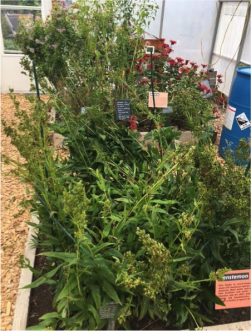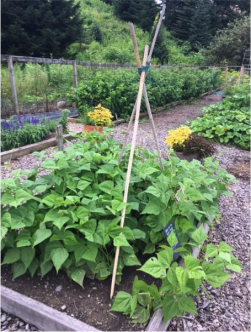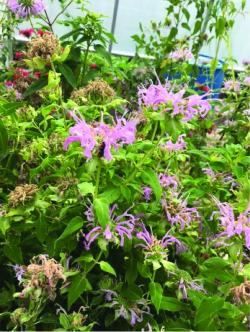Project Beds Update, July 26 2017
By Amanda Sudilovsky ’19 (2017 Cornell Botanic Gardens Intern)
Since the last blog post, many of the project beds have continued to differentiate themselves between inside and outside of the high tunnel. In this time, the beds have each received a total of 7 inches of rain, or 91 gallons of water. In July of 2016, Tompkins County only received a maximum of 0.49 inches of rain during a single rain event. By comparison, in July of this year, Tompkins County dropped 2.41 inches of rain during a single rain event. It is predicted that as climate change continues, we will see an increased frequency of these large events with greater than 1-2” of precipitation falling during a single storm. This substantial increase in the amount of precipitation may cause noticeable differences in the plants from the previous drought year.
The indeterminate black beans have developed significantly to the point that we have set up poles along which they can climb. We expect more flowers to abort on those growing in the tunnel due to the high temperatures to which they are exposed. Follow them through the season and see if you can distinguish a difference.
The Monarda fistulosa and Penstemon digitalis both had to be tied up to prevent them from drooping into the walkway. Finally, predatory mites (biocontrols) have been added to the beans to prevent spidermite damage to the plants. So far, we have not noticed any twospotted spider mites on the beans that caused damage in previous years. Parasitic wasps have been introduced to the tunnel to control aphids on the Monarda didyma.
One of the important features of these past few weeks was the maintenance of a heat wave in the tunnel. We started this heat wave when the beans started to flower in order to test whether the exposure to high temperatures would cause the plants to drop flowers before producing fruit. This disruption could significantly decrease yields. At this point, the effects of the heat wave on the beans is unclear. (Shown left:The pole structure was created to provide support for the beans. Shown right: The Monarda and Penstemon were tied to keep the plants from being damaged on the ground.
The wheat in the tunnel fully matured during this time. It was harvested just a few days ago. The wheat outdoors will soon follow, but unfortunately, yields may be lower due to pests such as birds and chipmunks that have been feeding on the plants. Now we must begin to prepare for the next set of plants that will go in these project beds within the next month. Can you spot pollinators on the Monarda fistulosa shown below?












